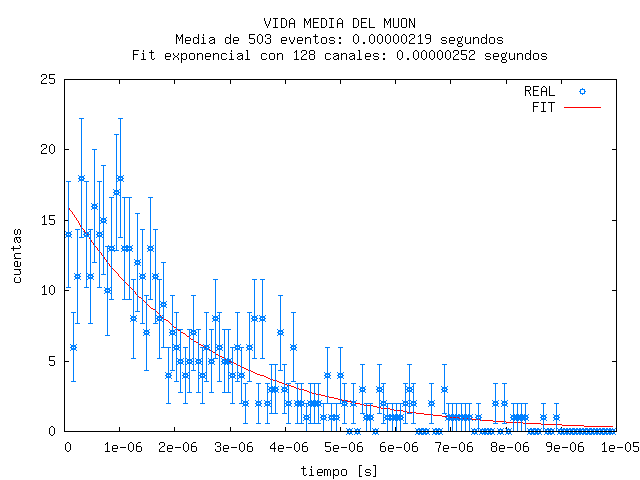The muon lifetime experiment
PART V: Four different versions of the experiment
FIRST EXPERIMENT - Runs 1 to 7
Coincidence triggers scope that records period
Both scintilators were used in this version of the experiment, with anodes to discriminators. The aim is to measure time between consecutive events in the BIG scintilator only if confirmed that the first one is a muon (coincidence). This strategy is motivated in bw limitation of the scope measurement (max 2 per second). Only logic module and osciloscope required (besides discriminators and HV, of course).
- Disc1 (BIG) = 4.5 (~10 Hz) to CH1
- Disc2 (MINOS) = 1.3 (~10 Hz)
- HV=2000V
- NIM coincidence (Disc1 & Disc2) to CH2 (trigger)
NIM output of BIG scintilator (Disc1) to scope CH1, to measure doubles.
START: Coincidence of both scintilators, trigger scope in the center of the screen, in order to record the start that happened before trigger.
STOP: Scope timebase in 1 us/div, measuring period of CH1 in MEAS1, to PC, single sequence. If second pulse (electron) does not arrive in 10 us, scope reports infinite and resets. Else reports time between consecutive anode pulses, i.e. muon lifetime.
Record in PC, both double pulses (true stops) and false starts (in order to record rate).
Run until 500 double events were recorded (~5 days).
LAYOUT:
RESULTS: Histogram of true stops and mean:

RECORDED RATES: Muon rate (coincidence): 1 c/3 s. Double rate: 1 c/300muons ~= 1 c/900 s
Limitations of this version. The coincidence rate depends on first scintilator reduced area (MINOS). Limitation of scope in recording small periods.
Recorded mean value: 2.19 usec !!. Statistics are not enough for a good exponential fit. Efficiency must be raised. See next experiment.
